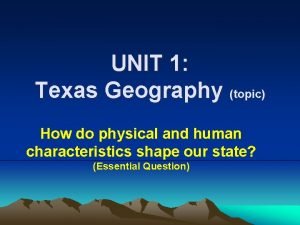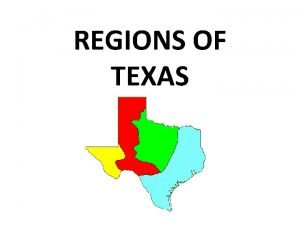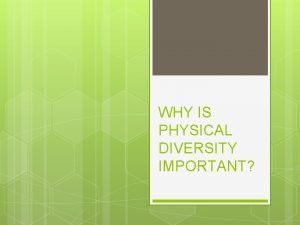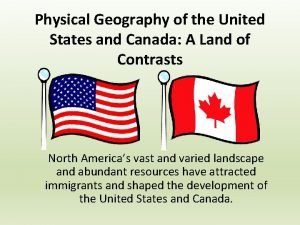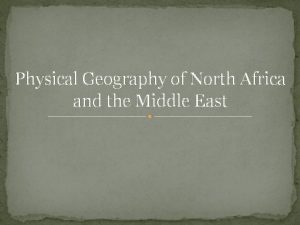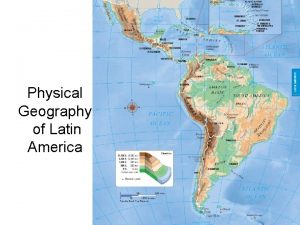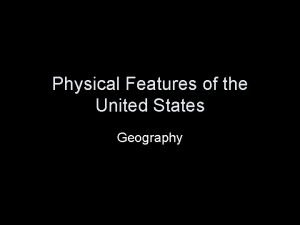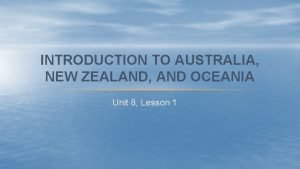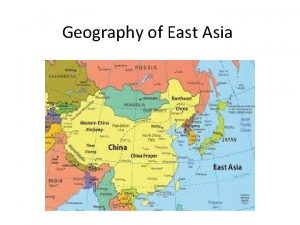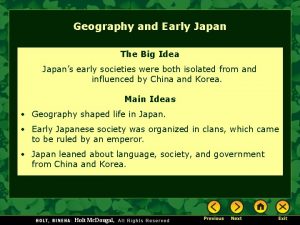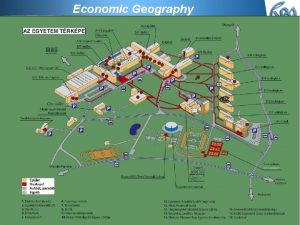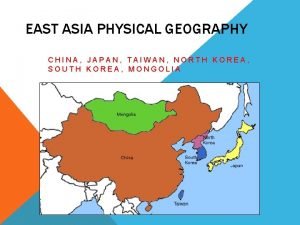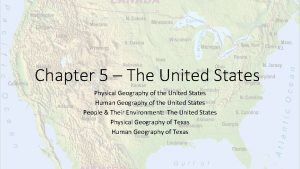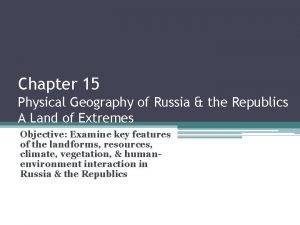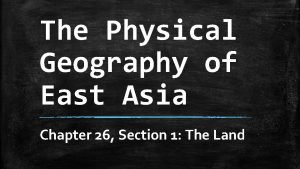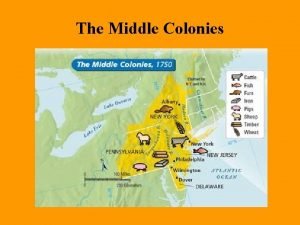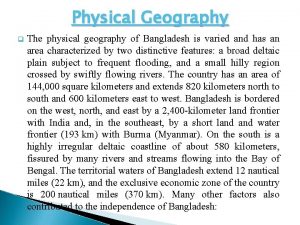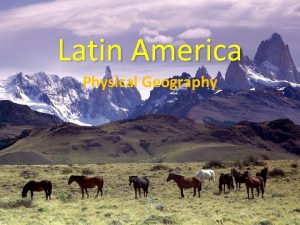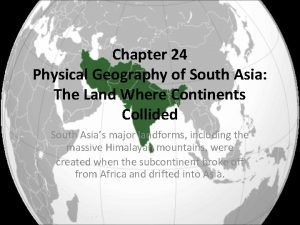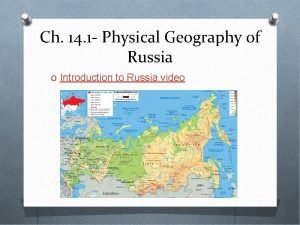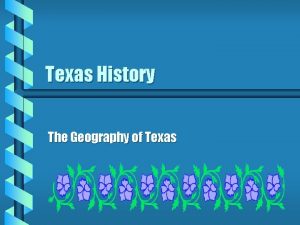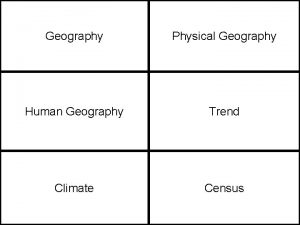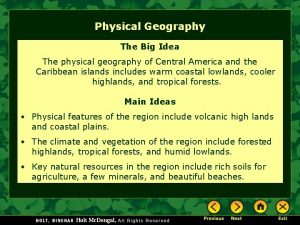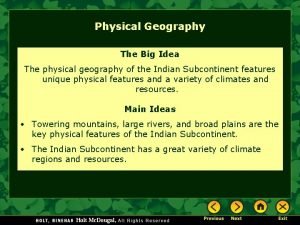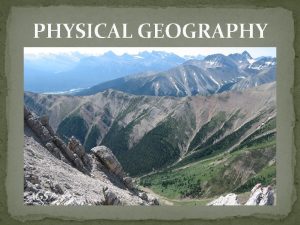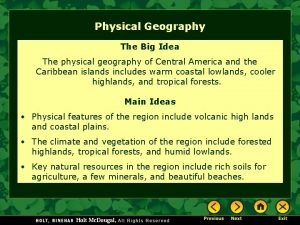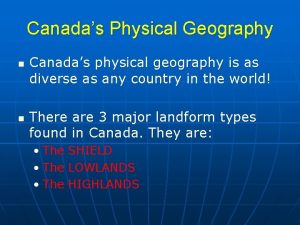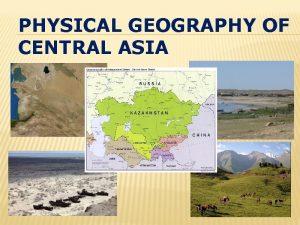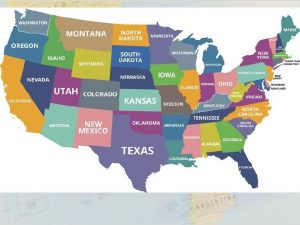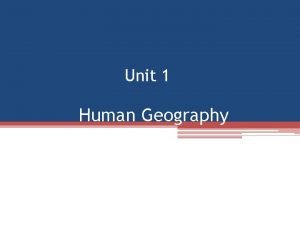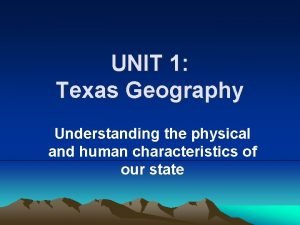UNIT 1 Texas Geography topic How do physical






































- Slides: 38

UNIT 1: Texas Geography (topic) How do physical and human characteristics shape our state? (Essential Question)

Era of Natural Texas and Its People • What is an era? A fixed period of time characterized by particular events, features, developments, or people. • Why do historians divide history into eras? Historians divide history into eras in order to create blocks of time that have similar characteristics in order to organize and present information about the past.

Era of Natural Texas and Its People • TEKS 1 A – Identify the major eras in Texas history, describe their defining characteristics, and explain why historians divide the past into eras, including Natural Texas and its People; Age of Contact; Spanish Colonial; Mexican National; Revolution and Republic; Early Statehood; Texas in the Civil War and Reconstruction; Cotton, Cattle, and Railroads; Age of Oil; Texas in the Great Depression and World War II; Civil Rights and Conservatism; and Contemporary Texas

6 Geographical Questions • Location – Where is it? • Place – What is it like? • Regions – How does it compare to other places? • Human-Environment Interaction – How do humans react to their environment and how does it affect them? • Human Systems • Physical Systems

Location – Where is it? • Absolute Location – The exact location of a place on the earth’s surface • Relative Location – The location of a place in relation to other places • The Absolute location and Relative location of Texas affect it in many ways – How has Texas’ relative location to Mexico affected it? (Left Column) *Turn and talk to a partner

chunk

Place – What is it like? • Place refers to the physical and human characteristics of a location • Physical Characteristics include: – Landforms, Climate, plants, animals • Human Characteristics include: – Language, Religion, Architecture, Music, Politics, ways of life

Physical Characteristics


Human Characteristics



Regions – How does it compare to other places? • Geographers divide areas into regions in order to better study them. • Regions are places that are united based on common characteristics • Regions can be based on physical, human, business and other characteristics

4 Natural Regions of Texas


Human-Environment Interaction How do humans react to their environment and how does it affect them? Use, adapt to or change. • Ex: Pollution Deforestation Hurricanes/Tornadoes Farming Damming Rivers to make lakes


• Texans have adapted and modified the environment by: – building dams on rivers to harness power for electricity. – irrigating the farms in the Great Plains region to yield sufficient crops such as cotton, wheat, rice, corn, etc.


Human Systems • Movement - How people move through the environment • Cultural Diffusion - new ideas brought by migrating people become widely accepted. Examples? • People bring ideas and goods with them when they move from one place to another.

Physical Systems • Geographers analyze physical systems such as mountains, volcanoes, hurricanes, glaciers to see how they interact with and shape places and regions. • They also study plant and animal ecosystems that depend on each other and their surroundings in places and regions for their survival.

Movement in Texas


Roy Bedichek He was an author and speaker; considered a “Naturalist” who traveled and documented the Texas landscape for over 30 years. Died in 1959.


Texas has the most varied climate of any other state in the U. S. It even varies greatly from one area of the state to the next.

Absolute Location • Texas lies in what are called the middle latitudes, the region about midway between the equator and the north pole. • Because of this absolute location of Texas being not very far north of the equator, it has mild winters, and because it is not very far south of the north pole is has mild summers.

Northers • Sudden, icy blasts of cold air, called northers, extend south from Canada and sweep across the plains of Texas. • Despite its overall warmth, Texas is subject to periods of cold weather.

Storms • Violent storms form when cool air from the north collides with moist warm air from the Gulf of Mexico. • Because Texas is on the Gulf, destructive storms such as hurricanes sometimes sweep across the state.

Relative Location • Because Texas is on the gulf coast, breezes from the Gulf of Mexico cool Texas in the summer and warm it in the winter. • Moisture from the Gulf gives Texas a lot of its rainfall. However, some parts of Texas are so far from The Gulf it has little effect on climate there. In the hot, dry areas, water is a precious, natural resource.

Elevation • Elevation also affects the Texas climate. The temperature cools by 3 degrees every 1000 -foot rise in elevation. • The temperature rises as elevation decreases


Texas Growth by Ethnicity

Texas Population 1800 -1850

Texas Population 1850 -2040

TX Population 1800 -2000

Texas Metropolitan Growth

TX Population By Age
 Physical geography of texas
Physical geography of texas How to write a clincher sentence
How to write a clincher sentence Broad and specific topic examples
Broad and specific topic examples Geography form one topic 2
Geography form one topic 2 Unit 6 review questions
Unit 6 review questions Topic 4 physical behavior of matter
Topic 4 physical behavior of matter Ap human geography frq format
Ap human geography frq format 5 themes of geography ap human geography
5 themes of geography ap human geography Proruption ap human geography
Proruption ap human geography How many regions are in texas
How many regions are in texas Physical diversity
Physical diversity Physical geography of us
Physical geography of us Physical geography of north africa
Physical geography of north africa Physical features of south america
Physical features of south america What are some physical features of the united states
What are some physical features of the united states The physical geography of northern europe
The physical geography of northern europe Web quest: geography of the spanish speaking world
Web quest: geography of the spanish speaking world Branch of geography
Branch of geography Lesson 1 physical geography of australia and new zealand
Lesson 1 physical geography of australia and new zealand Asia geography
Asia geography Branches of geography
Branches of geography Japans physical geography
Japans physical geography Physical geography definition
Physical geography definition Taiwan physical geography
Taiwan physical geography Physical geography of the united states
Physical geography of the united states Chapter 27 physical geography of east asia
Chapter 27 physical geography of east asia Russia and the eurasian republics physical map
Russia and the eurasian republics physical map Chapter 15 lesson 1 physical geography of north africa
Chapter 15 lesson 1 physical geography of north africa Chapter 13 lesson 1 physical geography of eastern europe
Chapter 13 lesson 1 physical geography of eastern europe Physical geography of east asia
Physical geography of east asia Middle colonies geography
Middle colonies geography Geography of bangladesh
Geography of bangladesh Physical geography of northern europe
Physical geography of northern europe South america highlands
South america highlands Japan physical geography
Japan physical geography Canada's physical geography
Canada's physical geography South asia physical geography
South asia physical geography Northwestern europe countries
Northwestern europe countries Reteaching activity 14 physical geography of russia
Reteaching activity 14 physical geography of russia
